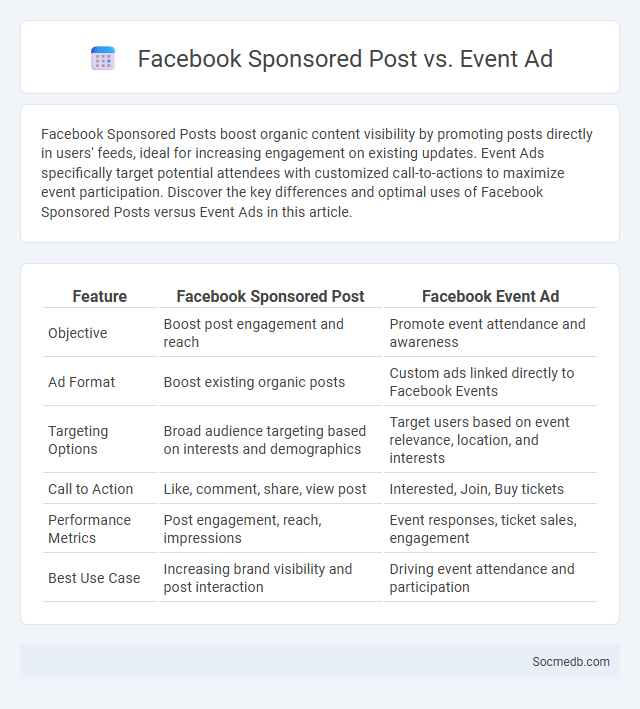
Photo illustration: Facebook Sponsored Post vs Event Ad
Facebook Sponsored Posts boost organic content visibility by promoting posts directly in users' feeds, ideal for increasing engagement on existing updates. Event Ads specifically target potential attendees with customized call-to-actions to maximize event participation. Discover the key differences and optimal uses of Facebook Sponsored Posts versus Event Ads in this article.
Table of Comparison
| Feature | Facebook Sponsored Post | Facebook Event Ad |
|---|---|---|
| Objective | Boost post engagement and reach | Promote event attendance and awareness |
| Ad Format | Boost existing organic posts | Custom ads linked directly to Facebook Events |
| Targeting Options | Broad audience targeting based on interests and demographics | Target users based on event relevance, location, and interests |
| Call to Action | Like, comment, share, view post | Interested, Join, Buy tickets |
| Performance Metrics | Post engagement, reach, impressions | Event responses, ticket sales, engagement |
| Best Use Case | Increasing brand visibility and post interaction | Driving event attendance and participation |
Understanding Facebook Sponsored Posts
Facebook Sponsored Posts leverage targeted advertising algorithms to reach specific demographics based on user behavior, interests, and location data. These posts increase brand visibility and engagement by appearing seamlessly within users' news feeds, using optimized keywords and compelling multimedia content. Analyzing post performance through Facebook Insights allows marketers to refine strategies and maximize return on ad spend.
What Are Facebook Event Ads?
Facebook Event Ads are targeted advertisements designed to promote events on the Facebook platform, increasing visibility and engagement from specific audience segments. These ads enable organizers to reach potential attendees by leveraging Facebook's advanced targeting options such as demographics, interests, and behaviors. Event Ads also provide real-time analytics to track impressions, click-through rates, and RSVPs, optimizing event promotion strategies effectively.
Key Differences Between Sponsored Posts and Event Ads
Sponsored posts integrate seamlessly into your social media feed, leveraging organic content style to subtly promote products or services, often targeting engagement and brand awareness. Event ads are specifically designed to drive attendance and interaction by highlighting event details with clear call-to-actions, offering precise audience targeting based on interests and behaviors related to events. Your marketing strategy can benefit from understanding these distinctions to optimize ad spend and achieve tailored campaign goals.
Audience Targeting Capabilities
Social media platforms offer advanced audience targeting capabilities that allow you to reach specific demographics, interests, and behaviors with precision. By leveraging data such as age, location, browsing habits, and engagement patterns, you can tailor your marketing campaigns to increase relevance and conversion rates. Effective audience targeting enhances your ability to connect with potential customers and maximize return on investment.
Ad Placement and Visibility
Effective ad placement on social media platforms significantly enhances your campaign's visibility by targeting the right audience segments based on demographics, interests, and online behavior. Leveraging advanced algorithms and real-time data analytics ensures that your ads appear in prime locations, such as news feeds, stories, and sidebar banners, maximizing engagement. Optimizing ad formats and timing further increases the likelihood that your message captures attention and drives meaningful interactions.
Cost Comparison: Sponsored Post vs Event Ad
Sponsored posts typically offer cost-effective brand exposure by targeting specific demographics with tailored content, costing between $200 to $5,000 per post depending on influencer reach. Event ads demand a higher budget, averaging $1,000 to $10,000, as they involve promoting time-sensitive events to drive registrations or attendance across multiple platforms. Comparing ROI, sponsored posts excel in engagement and brand awareness, while event ads yield direct conversions and measurable attendance metrics.
Engagement Metrics and Performance
Engagement metrics such as likes, shares, comments, and click-through rates are crucial indicators of social media performance and audience interaction. Analyzing these metrics helps marketers optimize content strategies, increase user retention, and improve brand visibility across platforms like Facebook, Instagram, and Twitter. High engagement rates correlate with enhanced algorithmic favorability, driving organic reach and boosting overall campaign effectiveness.
Best Use Cases for Each Ad Type
Image ads excel at driving brand awareness by capturing attention with high-quality visuals on platforms like Instagram and Facebook. Video ads boost engagement and conversions through storytelling and demonstrating product features, proving effective on YouTube and TikTok. Carousel ads offer interactive experiences by showcasing multiple products or features, enhancing click-through rates especially on Facebook and LinkedIn.
Tips for Optimizing Each Facebook Ad Format
Facebook ad formats vary, including carousel, video, slideshow, and collection, each requiring tailored optimization strategies. You should use high-quality visuals, concise copy, and clear calls to action for carousel ads to engage users with multiple product images or features. For video ads, focus on captivating the audience within the first few seconds with subtitles, compelling storytelling, and mobile-friendly dimensions to maximize viewer retention and conversions.
Choosing the Right Facebook Ad for Your Goals
Selecting the right Facebook ad format depends on your marketing objectives such as brand awareness, lead generation, or online sales. Utilize video ads to boost engagement and reach, while carousel ads effectively showcase multiple products or services to your target audience. Tailoring your ad strategy to align with your goals maximizes ROI and enhances Your campaign's overall performance.
 socmedb.com
socmedb.com